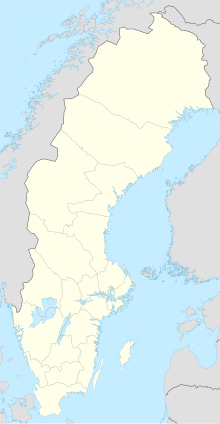Kiruna mine
 Kiruna Mine and townsite from ISS, 2016 | |
| Location | |
|---|---|
| Location | Kiruna |
| Municipality | Lapland |
| Country | Sweden |
| Coordinates | 67°51′01″N 020°11′34″E / 67.85028°N 20.19278°E |
| Production | |
| Products | Iron ore |
| Production | 27,500,000 tonnes of iron ore |
| Financial year | 2008 |
| History | |
| Opened | 1898 |
| Owner | |
| Company | Luossavaara-Kiirunavaara AB |
The Kiruna mine is the largest and most modern underground iron ore mine in the world.[1] The mine is located in Kiruna in Norrbotten County, Lapland.[1] The mine which is owned by Luossavaara-Kiirunavaara AB, a large Swedish mining company, has an annual production capacity of over 26 million tonnes of iron ore.[2] In 2008 the mine produced 27.5 million tonnes of iron ore.[1] The Kiruna mine has an ore body which is 4 kilometres (2.5 mi) long, 80 metres (260 ft) to 120 metres (390 ft) thick and reaching a depth of up to 2 kilometres (1.2 mi). Since mining began at the site in 1898, the mine has produced over 950 million tonnes of ore.[1]
In 2004, it was decided that the present centre of the municipality would have to be relocated to counter mining-related subsidence. The relocation will be made gradually over decades.
History
The Kiruna orebody was formed following intense volcanic activity. Iron-rich solutions precipitated the iron on to a syenite porphyry footwall.[3] Then the ore bed was covered by further volcanic deposits, quartz porphyry, and sedimentary rocks. Later the whole body was tilted to its current dip of 50 to 60°. Having a grading of more than 60% iron and an average of 0,9% phosphorus, the ore contains a very pure magnetite-apatite mix.[3]

The original reserve of the Kiruna mine was around 1.8 billion tonnes of ore.[1] In the beginning, surface mining was used, but the mine has been mined with the sublevel caving mining method since the 1960s. As of 2008 the Kiruna mine had estimated proven reserves of approximately 602 million tonnes grading 48.5% iron with probable reserves of 82 million tonnes grading 46.7% iron.[1] Measured, indicated and inferred resources add a further 328 million tonnes to the proven reserves. Until 1999 the deepest level of the mine reached 775 metres (2,543 ft), but after 1999 the new level went deeper reaching a depth of 1,045 metres (3,428 ft).[1] The 1,045 metres (3,428 ft) level can support current iron ore production until 2018. On October 28, 2008 Luossavaara-Kiirunavaara AB decided to go even deeper, the new level reaching a depth of 1,365 metres (4,478 ft) to be finished by 2012 at a cost of US$1.7 billion.[1]

Moving the town
The re-development of Kiruna is a reconstruction project, as the Kirunavaara mine, run by LKAB, undermines the current town center. Several buildings are to be moved or demolished. The town center is to be moved 3 kilometers to the east.[4]
In 2004, it was decided that the present centre of the municipality would have to be relocated to counter mining-related subsidence. The relocation would be made gradually over the coming decade. On January 8, 2007, a new location was proposed, northwest to the foot of the Luossavaara mountain, by the lake of Luossajärvi.[5]
The first actual work on moving the town was done in November 2007, when work on the new main sewage pipe started.[6]
In the same week, first sketches for the layout of the new part of the town became available.[7] The sketches include a travel centre, the new locations for the city hall and the church, an artificial lake and an extension of the Luossavaara hill into the city.[8] The location of the new section of the E10 is still uncertain, as is the location of the railway and the railway station. A more official sketch was published early in spring 2008, which was then discussed with various interest groups before a further version is to be produced.
In June 2010 the municipal council decided that the town would be moved eastwards (to 67°51′1″N 20°18′2″E / 67.85028°N 20.30056°E), in the direction of Tuolluvaara, instead of the proposed northwestern location.[9] The moving of the town was started in 2014 and the plan describes a process that continues to 2100.[10] White Arkitekter AB based in Stockholm and Ghilardi + Hellsten Arkitekter based in Oslo won the contract to design the new city together with researchers from Luleå and Delft Universities, which envisages a denser city centre with a greater focus on sustainability, green and blue infrastructure, pedestrians and public transport rather than automobiles.[11]
See also
References
- ^ a b c d e f g h "Kiruna Iron Ore Mine, Sweden". mining-technology.com. 2010. Retrieved 2010-08-29.[unreliable source?]
- ^ "Mining". LKAB. 2010. Retrieved 2010-08-29.
- ^ a b "Kiruna Iron Ore Mine". miningweekly.com. 2010. Retrieved 2010-08-29.
- ^ "Kiruna: the town being moved 3km east so it doesn't fall into a mine". The Guardian. 22 October 2014. Retrieved 29 October 2017.
- ^ TT (2007-01-08). "Klart med Kirunas flytt". Dagens Nyheter (in Swedish). Retrieved 2015-10-24.
- ^ Jessica Rosengren (2007-11-23). "Kirunaflytten är igång". Norrländska Socialdemokraten, (in Swedish). Retrieved 2015-10-24.
{{cite news}}: CS1 maint: extra punctuation (link) - ^ Jessica Rosengren (2007-11-23). "Nu finns det skiss över nya Kiruna". Norrländska Socialdemokraten (in Swedish). Retrieved 2007-11-25.
- ^ Skissförslag nov.-07 Archived 2008-04-08 at the Wayback Machine
- ^ "Framtida placeringen av Kiruna klar". Dagens Nyheter (in Swedish). 2010. Archived from the original on July 21, 2010.
{{cite news}}: CS1 maint: postscript (link) - ^ "FAQ - Kiruna kommun". www.kiruna.se. Archived from the original on 2016-09-18. Retrieved 2016-08-21.
{{cite web}}: Unknown parameter|deadurl=ignored (|url-status=suggested) (help) - ^ "Kiruna: How to move a town two miles east". BBC News. Retrieved 2014-03-06.
External links


